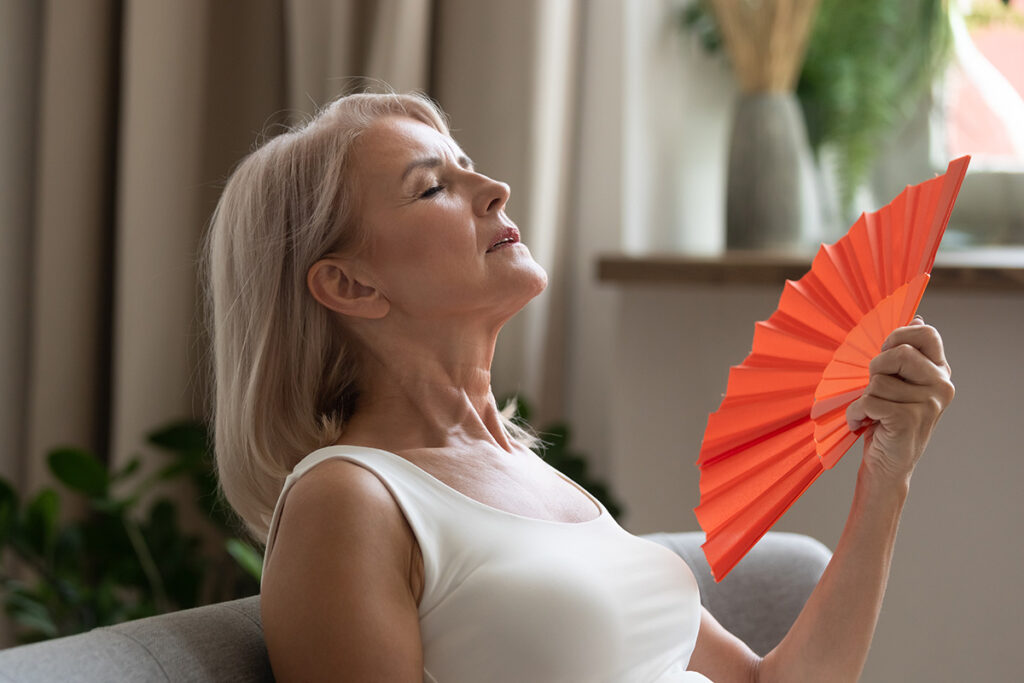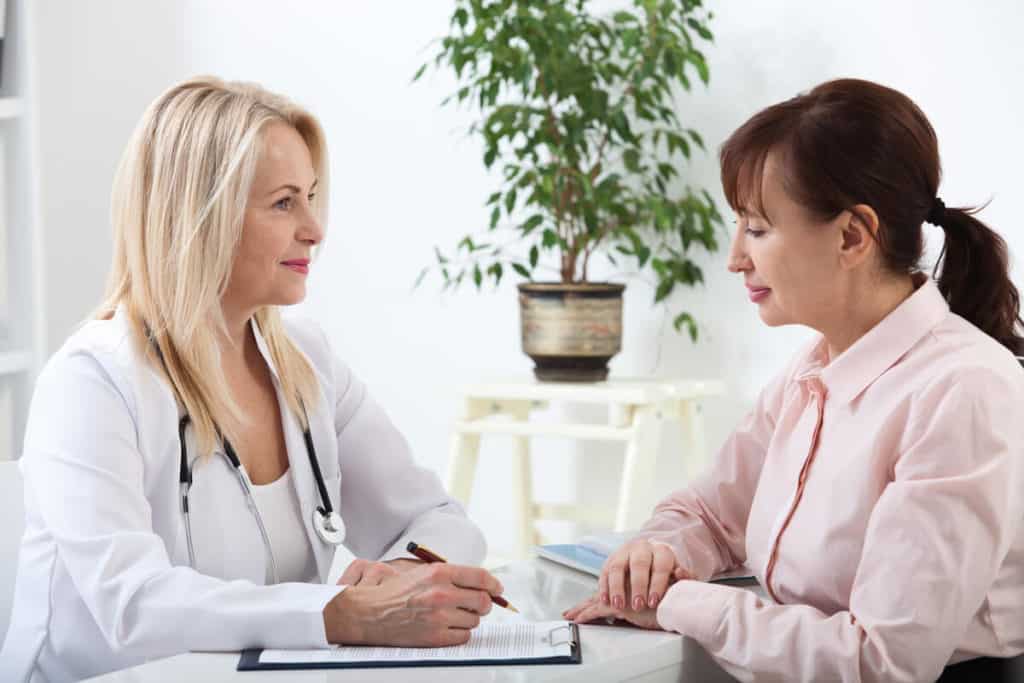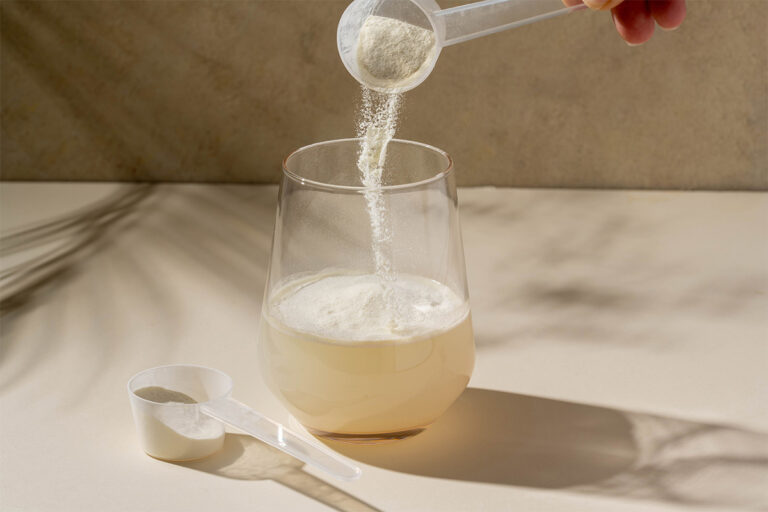Menopause is a natural phase of the aging process that all women will experience, typically unfolding over several years as part of the menopausal transition. The average woman reaches menopause between the ages of 49–52, marking the end of her reproductive years. From that point forward, women will spend roughly 30–40% of their lives in the postmenopausal stage.
While menopause is a normal biological process, it’s not always symptom-free—about two-thirds of women report experiencing at least some of the physical or emotional symptoms associated with this transition. Fortunately, decades of research have allowed us to better understand menopause, symptoms associated with it, and how to treat them, greatly improving the overall quality of life for women as they age.
Stages of menopause
Menopause is defined by the absence of a menstrual period (amenorrhea) for 12 consecutive months, which marks the end of the reproductive years.
There’s no specific test to determine when a woman’s last period will be or when menopause symptoms will stop. While the onset of menopause typically occurs after the age of 45, women can enter menopause earlier in life.
Premature menopause, or early menopause, occurs when a woman enters menopause before the age of 40 and can be a result of a variety of reasons, including:
- Lower body mass index (BMI)
- Nulliparity (hasn’t previously given birth to term)
- Smoking
- Surgical menopause due to hysterectomy (removal of uterus) or oophorectomy (removal of ovaries)
- Use of levonorgestrel intrauterine device (IUD)
The Stages of Reproductive Ageing Workshop (STRAW) has identified three primary stages of reproductive aging: the reproductive years, menopausal transition, and postmenopause.
Perimenopause
Perimenopause, also known as the menopausal transition, can begin up to three years before the final menstrual period (FMP). This stage typically lasts four to five years and marks the transition from a woman’s reproductive years into menopause.
During perimenopause, women will begin to experience hormonal changes. Follicular stimulating hormone (FSH) and luteinizing hormone (LH) levels increase, which causes estrogen levels to fluctuate while inhibin B levels decrease.
These hormones directly impact a woman’s ovarian function, resulting in the cessation of ovulation due to the loss of oocyte (immature egg) production. The end of ovulation results in the failure to produce progesterone.
While all of these hormonal levels are changing, the ovaries carry on with testosterone production, contributing to the overall hormonal imbalance. These hormonal changes will result in an irregular menstrual cycle and other symptoms that can vary in frequency and severity.
Perimenopause is divided into two stages:
- Early Stage–Characterized by menstrual cycle variability and increased FSH levels
- Late Stage–Characterized by longer periods of amenorrhea ranging from 60 days to one year
Menopause
When a woman has gone a full year without having a menstrual period, she has entered menopause. Many of the signs of menopause overlap with the signs and symptoms of perimenopause, which generally continue into this stage, but may begin to decline in frequency and severity.
Postmenopause
Postmenopause starts the first year after the FMP and signifies the stage of a woman’s life after FMP and menopause. Most women have entered menopause by age 60, although women can experience symptoms into their 80s. During this stage, women will have low estrogen levels and high FSH levels due to years of declining ovarian function.
Signs and symptoms of menopause
By the year 2030, there will be over one billion women worldwide entering one of the stages of menopause, with 85% experiencing psychological and/or physical symptoms. The type and severity of symptoms experienced can vary based on the following factors:
- Activity level
- BMI
- Ethnicity
- Geographic location
- History of anxiety and depression
- Medications
- Previous/current illnesses
- Smoking
Vasomotor symptoms
The most commonly experienced and recognized symptoms during menopause are vasomotor symptoms, believed to be a result of low estrogen and other hormonal fluctuations. These symptoms include hot flashes (hot flushes) and night sweats, which tend to affect at least 65% of menopausal women.
Vasomotor symptoms can significantly affect quality of life due to their irregularity and sudden onset, which can disrupt sleep, work, and social events. Sleep disturbances caused by vasomotor symptoms account for up to 60% of complaints reported by menopausal women.
The disruption to daily life caused by vasomotor symptoms can also impact mood and cognitive function, such as attention and memory. Vasomotor symptoms can continue throughout all stages of menopause, lasting for up to thirteen years in various intensities.

Vasomotor symptoms, such as hot flashes, can be disruptive and reduce overall quality of life.
Hot flashes can begin before the FMP and continue throughout menopause, with one-third of women experiencing them for more than ten years after their FMP.
Hot flashes are characterized by random periods of heat that are primarily felt in the upper body and often experienced in conjunction with perspiration, clammy skin, anxiety, and palpitations, followed by a feeling of cold. They can last anywhere between five and 30 minutes and may occur multiple times throughout the day. The symptoms of hot flashes can feel very similar to anxiety or panic attacks.
Night sweats are hot flashes that occur during the night, often disturbing sleep. During menopause, the body’s thermoregulatory set point is narrower, so the body can perspire at lower body temperatures.
Risk factors for vasomotor symptoms
There are a variety of risk factors that can impact the frequency and severity of hot flashes and night sweats, including:
- Genetic predisposition
- History of anxiety
- Intake of alcohol, hot beverages, and spicy or hot foods
- Medications
- Stress
- Warm environments
Vasomotor symptoms prevention and management
The following recommendations may help prevent and manage vasomotor symptoms:
- Dress in layers
- Keep a clean and dry pair of clothes nearby
- Keep a fan nearby
- Maintain cool room temperatures
- Use self-cooling gel pillows
Urogenital symptoms
As a result of the decline in estrogen levels that occurs throughout menopause, there’s a decline in the production of collagen, elastin, and moisture in the body.
Along with contributing to visible signs of aging, such as wrinkles and creases, these changes affect general vaginal health, resulting in vulvovaginal atrophy (VVA)—a condition that causes vaginal inflammation, dryness, and thinning of the vaginal walls. VVA can result in vaginal tearing and bleeding after menopause.
It’s estimated that almost half of menopausal women experience urogenital and VVA symptoms. Many don’t pursue treatment options due to shame or embarrassment, and those who do are often not properly diagnosed. Urogenital symptoms of menopause include:
- Atrophic vaginitis (inflammation)
- Dry and thin vaginal lining
- Dyspareunia (painful intercourse)
- Dysuria (painful urination)
- Fluctuation in vaginal bacteria
- Higher vaginal pH
- Incontinence
- Increased frequency and urgency of urination
- Increased risk of urinary tract infections (UTIs)
- Narrower and shorter vagina
- Nocturia (nighttime urination)
- Vaginal fissures (tears)
The following treatment options have been shown to help some urogenital symptoms:
- Probiotics
- Vaginal lubricants
- Vaginal moisturizers
Other common symptoms
Many other symptoms are associated with the menopause transition, including:
- Anxiety
- Cardiovascular disease (CVD)
- Change in body shape due to more centralized adipose tissue (fat)
- Change in cognitive function, such as memory loss, brain fog, and decreased concentration
- Depression
- Increased facial hair
- Increased skin aging, characterized by wrinkling and creasing
- Migraines
- Osteoporosis
- Poor quality of sleep
- Thinning hair on the scalp
- Weight gain and metabolic changes due to insulin resistance
Women are at a two–four times greater risk of depression during menopause than in their reproductive years. Having a history of depression can further increase a woman’s likelihood of experiencing menopausal depression up to five times.

Menopause symptom support
Many treatment options are available to help prevent and manage the symptoms of menopause, such as pharmaceutical medications (hormonal and non-hormonal), natural health products, cognitive therapies, and various lifestyle changes.
Hormone replacement therapy (HRT), including estrogen therapy (ET), is the use of hormonal medications to address the various symptoms that come with menopause. Most research examining treatment options for menopause focus on ET, which has been shown to be an effective intervention in the treatment of vasomotor and urogenital symptoms when used orally, transdermally, or vaginally.
The 2002 Women’s Health Initiative Study (WHI) identified many of the associated risks of ET and HRT, which may include:
- Coronary artery disease (CVD)
- Gallbladder disease
- Incontinence
- Invasive breast cancer
- Nausea
- Stroke
- Tender breasts
- Vaginal bleeding
- Venous thrombosis (blood clot)
However, later analyses have clarified that the balance of risks and benefits of HRT depends significantly on patient age, the timing of HRT initiation, the type of hormones administered (synthetic vs. bioidentical), and the route by which they are administered (oral vs. transdermal).
Menopause supplements for symptom support
Approximately 51% of women use complementary and alternative medicine, and more than 60% perceive it to help alleviate menopausal symptoms. The use of natural health products tends to be the highest among peri- and postmenopausal women.
While there are a variety of popular supplements used to help address the symptoms of menopause, more evidence is needed to demonstrate their efficacy, safety, or both.
Ashwagandha
Ashwagandha (Withania somnifera) is a traditional herb used in Ayurvedic medicine. Its neuroprotective, sedative, and adaptogenic properties have garnered growing scientific interest for its potential to support women during menopause. These properties are particularly relevant for (peri)menopausal women, who face an increased risk of anxiety, depression, and sleep disturbances as hormone levels fluctuate.
Elevated perceived stress has been linked to more severe menopausal symptoms. For example, one study found that women who had recently experienced a stressful life event reported 21% more vasomotor symptoms than those who weren’t under similar stress. While most clinical trials on ashwagandha haven’t specifically targeted menopausal women, multiple randomized controlled trials (RCTs) have demonstrated its safety and efficacy in reducing symptoms of stress, anxiety, and depression in broader populations.
Black cohosh
Black cohosh is a highly researched herbal supplement used for menopause symptoms. This medicinal herb is believed to have estrogenic effects. However, there’s currently a lack of research to support this claim. Research does suggest that it may help alleviate hot flashes and mood disturbances due to its effect on serotonin receptors.
In an RCT involving 62 menopausal women over a three-month period, black cohosh supplementation led to a significant reduction in vasomotor symptoms, with effects comparable to ET. Notably, black cohosh didn’t stimulate endometrial (uterine lining) thickening—a known risk associated with unopposed ET in women with an intact uterus.
Black cohosh isn’t safe to use for pregnant or lactating women. Potential side effects of using black cohosh can include dizziness, headaches, and mild digestive issues.
Rhaponic rhubarb
Rhaponic rhubarb, specifically the standardized extract ERr 731 derived from Rheum rhaponticum roots, has shown considerable promise in alleviating menopausal symptoms through its selective activation of estrogen receptor-beta. This mechanism allows it to exert estrogenic effects without stimulating estrogen receptor-alpha, which is believed to minimize the risk of estrogen-related tissue proliferation (endometrial thickening).
Clinical trials and long-term observational studies have shown that ERr 731 can significantly reduce the severity of menopausal symptoms, including hot flashes, anxiety, and overall symptom burden, and improve quality of life.
Saffron
Derived from the Crocus sativus flower, saffron may improve symptoms of anxiety and depression by increasing serotonin and dopamine levels. Research shows that it’s as effective as fluoxetine (a pharmaceutical antidepressant often prescribed to treat vasomotor symptoms of menopause) in treating depressive symptoms.
Additionally, in a small RCT including 60 postmenopausal women, saffron was shown to be more effective than placebo in treating hot flash-associated depression.
Vitex agnus-castus
Used to regulate menstrual cycles, Vitex agnus-castus, also known as chaste tree berry, has been shown to be beneficial for women going through perimenopause who are experiencing irregular periods due to its progesterone-like effects. For years, it has been a popular medicinal herb used and approved in Germany to treat PMS symptoms and irregular menstruation.
Although research on Vitex for other menopausal symptoms is limited, one small double-blind RCT found that an eight-week supplementation protocol led to reductions in overall menopausal symptom scores, including anxiety and vasomotor symptoms, in women aged 48 to 58.

Mental health support
In addition to conventional hormone therapy and supportive dietary supplements, women going through menopause may benefit from specific mental health interventions, such as cognitive behavioral therapy (CBT), biofeedback and relaxation training, and awareness and support groups. These options can help women be better equipped to handle and adapt to the symptoms and changes experienced during the menopause transition, resulting in a more positive outlook on menopause and aging.
The bottom line
Menopause is a normal part of aging. It’s important to stay informed and educate yourself on the signs, symptoms, and what to expect. Talk to your integrative healthcare provider, who can help you determine the best and safest treatment options for you.
References
- Arnot, M., Emmott, E. H., & Mace, R. (2021). The relationship between social support, stressful events, and menopause symptoms. PLOS ONE, 16(1), e0245444. https://doi.org/10.1371/journal.pone.0245444
- Bromberger, J. T., Kravitz, H. M., Chang, Y., et al. (2013). Does risk for anxiety increase during the menopausal transition? Study of Women’s Health Across the Nation. Menopause: The Journal of the North American Menopause Society, 20(5), 488–495. https://doi.org/10.1097/gme.0b013e3182730599
- Chauhan, S., Tiwari, A., Verma, A., et al. (2024). Exploring the Potential of Saffron as a Therapeutic Agent in Depression Treatment: A Comparative Review. The Yale Journal of Biology and Medicine, 97(3), 365–381. https://doi.org/10.59249/xurf4540
- Cunningham, A. C., Hewings-Martin, Y., Wickham, A. P., et al. (2025). Perimenopause symptoms, severity, and healthcare seeking in women in the US. Npj Women’s Health, 3(12). https://doi.org/10.1038/s44294-025-00061-3
- Furness, S., Roberts, H., Marjoribanks, J., et al. (2012). Hormone therapy in postmenopausal women and risk of endometrial hyperplasia. Cochrane Database of Systematic Reviews, 2012(8), CD000402. https://doi.org/10.1002/14651858.cd000402.pub4
- Geller, S. E., & Studee, L. (2005). Botanical and Dietary Supplements for Menopausal Symptoms: What Works, What Does Not. Journal of Women’s Health, 14(7), 634-649. doi:10.1089/jwh.2005.14.634
- Gracia, C. R., & Freeman, E. W. (2018). Onset of the Menopause Transition. Obstetrics and Gynecology Clinics of North America, 45(4), 585-597. doi:10.1016/j.ogc.2018.07.002
- Hasper, I., Ventskovskiy, B. M., Rettenberger, R., et al. (2009). Long-term efficacy and safety of the special extract ERr 731 of Rheum rhaponticum in perimenopausal women with menopausal symptoms. Menopause, 16(1), 117–131. https://doi.org/10.1097/gme.0b013e3181806446
- Harlow, S. D., Gass, M., Hall, J. E., et al. (2012). Executive summary of the Stages of Reproductive Aging Workshop 10: Addressing the unfinished agenda of staging reproductive aging. Climacteric, 15(2), 105-114. doi:10.3109/136971310.3109/13697137.2011.6506567.2011.650656
- Heger, M., Ventskovskiy, B. M., Borzenko, I., et al. (2006). Efficacy and safety of a special extract of Rheum rhaponticum (ERr 731) in perimenopausal women with climacteric complaints. Menopause, 13(5), 744–759. https://doi.org/10.1097/01.gme.0000240632.08182.e4
- Hickey, M., Szabo, R. A., & Hunter, M. S. (2017). Non-hormonal treatments for menopausal symptoms. Bmj. doi:10.1136/bmj.j5101
- Johnson, A., Roberts, L., & Elkins, G. (2019). Complementary and Alternative Medicine for Menopause. Journal of Evidence-Based Integrative Medicine, 24(24), 2515690X1982938. https://doi.org/10.1177/2515690×19829380
- Kashani, L., Esalatmanesh, S., Eftekhari, F., et al. (2018). Efficacy of Crocus sativus (saffron) in treatment of major depressive disorder associated with post-menopausal hot flashes: a double-blind, randomized, placebo-controlled trial. Archives of Gynecology and Obstetrics, 297(3), 717–724. https://doi.org/10.1007/s00404-018-4655-2
- Kaszkin-Bettag, M., Ventskovskiy, B. M., Kravchenko, A., et al. (2007). The special extract ERr 731 of the roots of Rheum rhaponticum decreases anxiety and improves health state and general well-being in perimenopausal women. Menopause, 14(2), 270–283. https://doi.org/10.1097/01.gme.0000251932.48426.35
- Kaufman , M. R., Ackerman, L. A., Amin, K. A., et al. (2025). The AUA/SUFU/AUGS Guideline on Genitourinary Syndrome of Menopause. J Urol, 0(0). https://doi.org/10.1097/JU.0000000000004589.
- Khaksarian, M., Behzadifar, M., Behzadifar, M., et al. (2019). The efficacy of Crocus sativus (Saffron) versus placebo and Fluoxetine in treating depression: a systematic review and meta-analysis. Psychology Research and Behavior Management, 12, 297–305. https://doi.org/10.2147/PRBM.S199343
- Kim, J., & Park, Y. J. (2017). Probiotics in the Prevention and Treatment of Postmenopausal Vaginal Infections: Review Article. Journal of Menopausal Medicine, 23(3), 139. doi:10.6118/jmm.2017.23.3.139
- Lopresti, A. L., Smith, S. J., Malvi, H., et al. (2019). An investigation into the stress-relieving and pharmacological actions of an ashwagandha (Withania somnifera) extract: A randomized, double-blind, placebo-controlled study. Medicine, 98(37), e17186. https://doi.org/10.1097/MD.0000000000017186
- Manson, J. E., Bassuk, S. S., Kaunitz, A. M., et al. (2020). The Women’s Health Initiative trials of menopausal hormone therapy: lessons learned. Menopause, 27(8), 918–928. https://doi.org/10.1097/gme.0000000000001553
- Mckee, J., & Warber, S. L. (2005). Integrative Therapies for Menopause. Southern Medical Journal, 98(3), 319-326. doi:10.1097/01.smj.0000154771.76292.76
- McKinlay, S. M., Brambilla, D. J., & Posner, J. G. (2008). The normal menopause transition. Maturitas, 61(1-2), 4–16. https://doi.org/10.1016/j.maturitas.2008.09.005
- Mikulska, P., Malinowska, M., Ignacyk, M., et al. (2023). Ashwagandha (Withania somnifera)—Current Research on the Health-Promoting Activities: A Narrative Review. Pharmaceutics, 15(4), 1057. https://doi.org/10.3390/pharmaceutics15041057
- Minkin, M. J. (2019). Menopause: Hormones, Lifestyle, and Optimizing Aging. Obstetrics and Gynecology Clinics of North America, 46(3), 501–514. https://doi.org/10.1016/j.ogc.2019.04.008
- Monteleone, P., Mascagni, G., Giannini, A., et al. (2018). Symptoms of menopause — global prevalence, physiology and implications. Nature Reviews Endocrinology, 14(4), 199-215. doi:10.1038/nrendo.2017.180
- Moreira, A. C., Silva, A. M., Santos, M. S., et al. (2014). Phytoestrogens as alternative hormone replacement therapy in menopause: What is real, what is unknown. The Journal of Steroid Biochemistry and Molecular Biology, 143, 61-71. doi:10.1016/j.jsbmb.2014.01.016
- Naseri, R., Farnia, V., Yazdchi, K., et al. (2019). Comparison of Vitex agnus-castus Extracts with Placebo in Reducing Menopausal Symptoms: A Randomized Double-Blind Study. Korean Journal of Family Medicine, 40(6), 362–367. https://doi.org/10.4082/kjfm.18.0067
- Okeke, T. C., Anyaehie, U. B., & Ezenyeaku, C. C. (2013). Premature Menopause. Annals of Medical and Health Sciences Research, 3(1), 90. https://doi.org/10.4103/2141-9248.109458
- Pandit, S., Srivastav, A. K., Sur, T. K., et al. (2024). Effects of Withania somnifera Extract in Chronically Stressed Adults: A Randomized Controlled Trial. Nutrients, 16(9), 1293. https://doi.org/10.3390/nu16091293
- Peacock, K., & Ketvertis, K. M. (2023). Menopause. National Library of Medicine; StatPearls Publishing. https://www.ncbi.nlm.nih.gov/books/NBK507826/
- Shah, J., Chandanani, S., Reddy, J., et al. (2021). Evaluation of the Efficacy and Safety of Rheum rhaponticum Root Extract (ERr 731) for Menopausal Symptoms in Perimenopausal Indian Women. Journal of Mid-Life Health, 12(2), 108–115. https://doi.org/10.4103/jmh.jmh_86_21
- Shams, T., Firwana, B., Habib, F., et al. (2013). SSRIs for Hot Flashes: A Systematic Review and Meta-Analysis of Randomized Trials. Journal of General Internal Medicine, 29(1), 204–213. https://doi.org/10.1007/s11606-013-2535-9
- Takahashi, T. A., & Johnson, K. M. (2015). Menopause. Medical Clinics of North America, 99(3), 521-534. doi:10.1016/j.mcna.2015.01.006
- Tandon, N., & Yadav, S. S. (2020). Safety and clinical effectiveness of Withania Somnifera (Linn.) Dunal root in human ailments. Journal of Ethnopharmacology, 255(112768), 112768. https://doi.org/10.1016/j.jep.2020.112768
- Wober, J., Möller, F., Richter, T., et al. (2007). Activation of estrogen receptor-β by a special extract of Rheum rhaponticum (ERr 731®), its aglycones and structurally related compounds. The Journal of Steroid Biochemistry and Molecular Biology, 107(3-5), 191–201. https://doi.org/10.1016/j.jsbmb.2007.04.002
- Wuttke, W., Seidlová-Wuttke, D., & Gorkow, C. (2003). The Cimicifuga preparation BNO 1055 vs. conjugated estrogens in a double-blind placebo-controlled study: effects on menopause symptoms and bone markers. Maturitas, 44, S67–S77. https://doi.org/10.1016/s0378-5122(02)00350-x
- Yu, K., Huang, Z.-Y., Xu, X.-L., et al. (2022). Estrogen Receptor Function: Impact on the Human Endometrium. Frontiers in Endocrinology, 13, 827724. https://doi.org/10.3389/fendo.2022.827724
- Zhang, F., & Cheng, L. (2024). Association between sleep duration and depression in menopausal women: a population-based study. Frontiers in Endocrinology, 15, 1301775. https://doi.org/10.3389/fendo.2024.1301775





